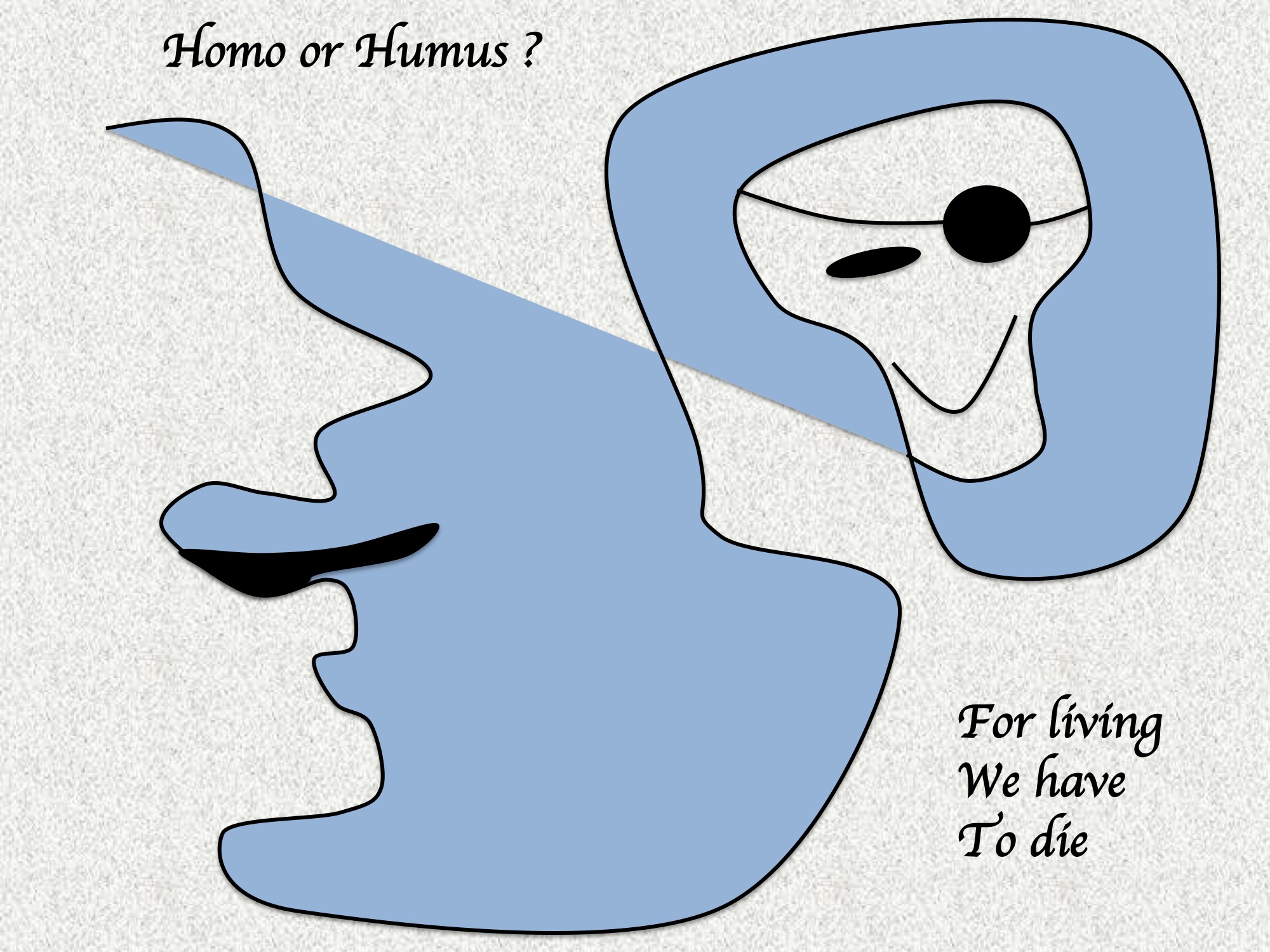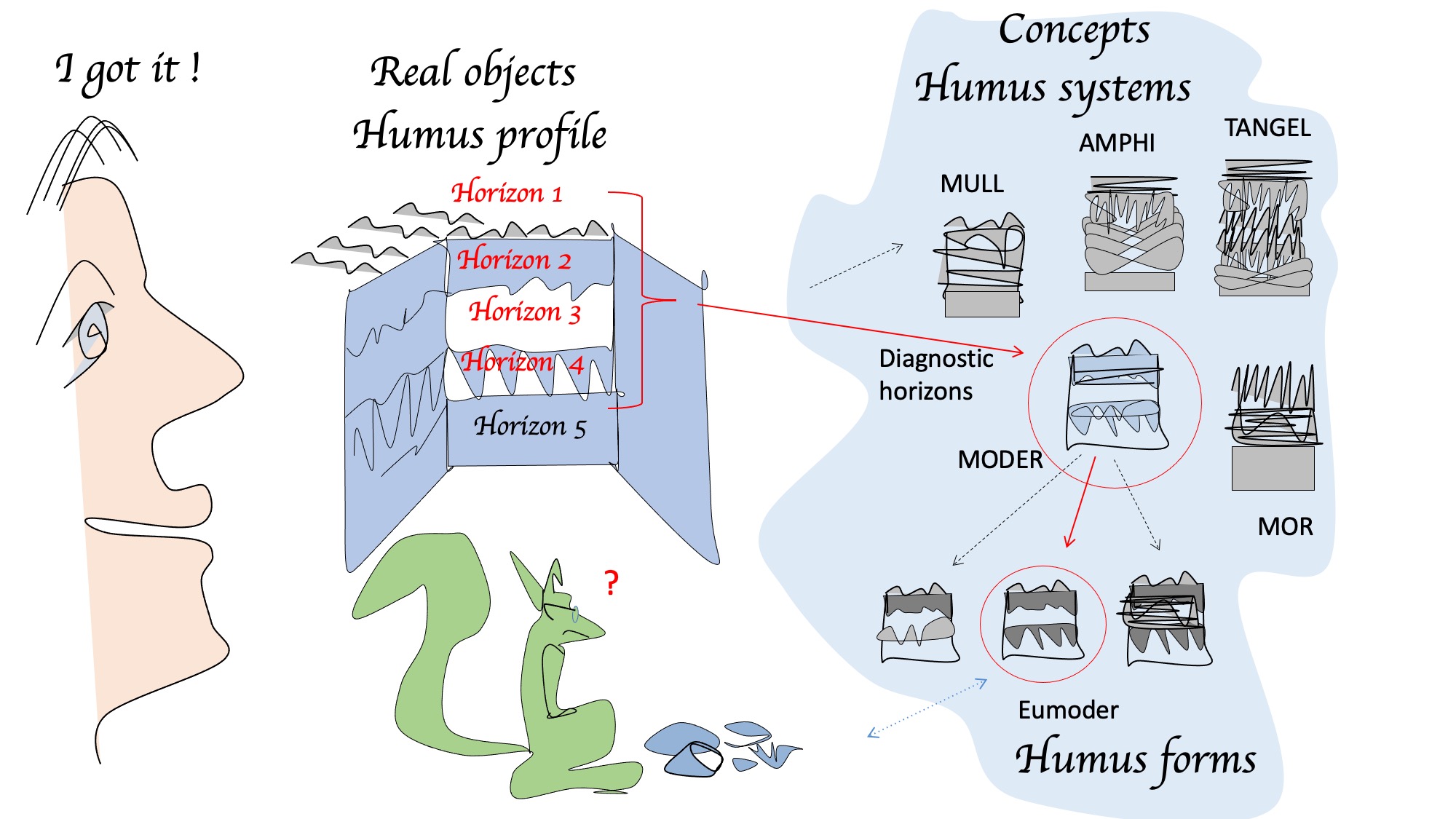Nobody really knows what "humus" is. Even if the same word is at the origin of "human". In this short entry we try to explain the reason for this coincidence (Part one: What's life?). Then we will explain what humus systems (chapter 2) and humus forms are (part 3).
- Humipedon
Part one: what's life?
Essentially, with the word "Humus" we intend the meeting point of two opposing processes: degradation and construction of organic molecules/bodies (organic = built around a skeleton of carbon atoms). Referring to the dominant biological part of these processes, it is preferable to use the terms of biodegradation and humification, respectively. Naturally you find humus in the top part of a soil. This part is called Humipedon is the point where the phenomena of life and death meet. Any dead body or body part naturally falls to the ground and is decomposed there. It is not even that easy to tell when a body is dead. A falling leaf, for example, can we say that it is more dead on the ground than when it was already yellow on the tree? If we leave aside these "border areas", we can say that when a leaf reaches the ground it is dead and is on to become something else. The future of a body under degradation is new life. To live, you must first die (Figure 1). Or vice versa, as in the question: "Was the chicken or the egg born first?"

Figure 1. To stay alive, people must die[1]. In a single person's time, an individual is born, grows and dies. Even in the time of the generation of a population. But something almost miraculous happens: the next generation never starts from the same point as the previous one, but from something different. It is this something different that evolves linearly over time, regardless of the life of the individual or the population. In this long-term process, humus is found between one generation and another, between the death of the first and the life of the second. For this reason it is intriguing as a concept. There are scientists who claim that humus does not exist[2], that there are molecules that change, but never humus. But if we think in this way, then we human beings don't even exist, because we are just molecules that change over time too. Not even Erwin Schrödinger was able to answer the question, and no one else did better than him[3]. The final impression is that to be able to live well is not necessary to know what life is.
The early Earth was devoid of life if we consider that life begins with a first "living cell". A name has also been found for it: LUCA (Last universal common ancestor: https://www.imperial.ac.uk/news/120606/who-what-luca/ ). Problem: to make a cell you need complex components that could be considered "already alive". It is objected that in order to be alive it is necessary to reproduce. Unfortunately, even an atom is so complex, if studied in its elementary components, that we have not yet understood what it is made of, except by activating our imagination. We don't know if an atom is "alive". At the molecular level, thinking that a DNA molecule is somewhat "alive" is not considered absurd. Although not everyone agrees that viruses are alive (https://www.scientificamerican.com/article/are-viruses-alive-2004/ ).
We love be thinking that Miller-Urey's soup[4] was a soil at its origins, an archaic very liquid humipedon. Certainly there is organic matter in the black space of the universe[5]. It is very likely that organic molecules from space were also present on the surface of planet Earth when LUCA was generated. Before LUCA there was only a Miller-Urey soup. Admitting this does not only mean that this is how life was born, but also that it may continue to generate like this; that LUCA was born in an embryo of "soil"; that this soil embryo still exists today and continues to generate life, even if conditions have changed. It is assumed that at the origin, every living embryo is a tiny Miller-Urey soup. In Miller-Urey's soup no living beings are born but ecosystems, ecosystems that contain parts of living beings or complete living beings that are not separate from their environment of genesis. We know the story for the next steps. Citing only the nerve centers of history, Darwin's evolution of species[6], explained by Lovelock[7] for the chemical-physical aspects at the planet level and by Margulis[8] for the biological ones at the level of living primordial entities, connected to the rest of the living as in the observations of Darwin. From the point of view of a soil scientist, the process of "genesis and evolution of ecosystems" is still active and should be seek in a sort of "humipedon". A pure biologist point of view can be similar when they investigate the boundary between life and death in cells. Usually the concept of apoptosis comes into play, which on the one hand kills and on the other creates[9][10].
Part two: Humus systems
Un humus system is an abstract category in which soil scientists set all humipedons that show a similar aspect and functioning. Imagine a specialist who has seen all the humipedons in the world and who wishes to tell others about them. Recall that the humiped is the superficial part of the soil, the first centimeters of soil, those that if you open a hole, you see that they are darker than the rest of the soil. If one asks this specialist to describe the hiumipedons he has encountered, he will have to classify them, put them in different boxes. Roughly he will say: "I saw humipedons in the water and they are usually very thick, organic and dark; then I saw buckets: in some there were earthworms, in others insects, mites, springtails; others were in unthinkable places, on the highest rocks in the world but also in the depths of the oceans .... "On planet earth the following have been provisionally described: 5 systems in fresh water, 2 in salt water, 5 in dry environments and 6 in" strange "environments and 2 anthropogenic. See photographs in Humipedons. See classification and distinctive characters in the Morpho-Functional Classification of the Planet's Humipedons.
Part three: Humus Forms
Once you know how to recognize humipedons, you want to see if within the category there are different "forms of them", i.e. humipedons that within the same humus system can be different from the other but not so different to end in another system. For example humipedons of the Mull system that never have leaves on the surface. You wonder "they too are made from earthworms, I see their droppings here and there ... why in this forest the earthworms eat all the leaves quickly, while in this other they don't? And it turned out that there are more palatable leaves than others, that some species of trees seem to want their leaves to be undigested to earthworms, that leaves remain a long time on poisoned soils .... In short, it is interesting to describe and be able to individuate 2 tso 4me different forms of humus in each humus system. Eventually, going into detail, the planet is covered with humipedons which can be classified into "humus systems", which in turn can be subdivided into "humus forms". This is already quite complicated and you can stop for a while (Figure 2).
 Figure 2. Humus systems and humus forms[1]. The figure shows an open profile divided into horizons. Each humus system is characterized by specific diagnostic horizons. Depending on the thickness of these horizons, humus forms can be identified within each humus system. The subdivision of the Moder system into three forms of humus has been illustrated on the figure. Hemimoder, Eumoder and Dysmoder. Eumoder is the "central" humus forms, corresponding to a typical Moder. To know more: https://www.sciencedirect.com/journal/applied-soil-ecology/vol/122/part/P1 ; https://www.sciencedirect.com/journal/applied-soil-ecology/vol/122/part/P2. There is also an application (TerrHum) to take to the field that helps to recognize these diagnostic horizons[11].
Figure 2. Humus systems and humus forms[1]. The figure shows an open profile divided into horizons. Each humus system is characterized by specific diagnostic horizons. Depending on the thickness of these horizons, humus forms can be identified within each humus system. The subdivision of the Moder system into three forms of humus has been illustrated on the figure. Hemimoder, Eumoder and Dysmoder. Eumoder is the "central" humus forms, corresponding to a typical Moder. To know more: https://www.sciencedirect.com/journal/applied-soil-ecology/vol/122/part/P1 ; https://www.sciencedirect.com/journal/applied-soil-ecology/vol/122/part/P2. There is also an application (TerrHum) to take to the field that helps to recognize these diagnostic horizons[11].
References
- Augusto Zanella; Jean-François Ponge; Jean-Michel Gobat; Jérôme Juilleret; Manuel Blouin; Michaël Aubert; Oleg Chertov; José Luis Rubio; Humusica 1, article 1: Essential bases – Vocabulary. Applied Soil Ecology 2018, 122, 10-21, 10.1016/j.apsoil.2017.07.004.
- Johannes Lehmann; Markus Kleber; The contentious nature of soil organic matter. Nature Cell Biology 2015, 528, 60-68, 10.1038/nature16069.
- Schrödinger, E.. What is Life? The Physical Aspect of Living Cell with Mind and Matter & Autobiographical Sketches; Cambridge University Press: Cambridge, 1967; pp. 112-114.
- Miller, Stanley L.; Urey, Harold C.; Organic Compound Synthes on the Primitive Earth. Science 1959, 130, 245-251.
- Sun Kwok; Yong Zhang; Mixed aromatic–aliphatic organic nanoparticles as carriers of unidentified infrared emission features. Nature 2011, 479, 80-83, 10.1038/nature10542.
- Darwin, Charles. On the Origin of Species by Means of Natural Selection or the Preservation of favoured races in the struggle for life; John Murray: Albemarle Street, London, 1859; pp. 502.
- James E. Lovelock; Lynn Margulis; Atmospheric homeostasis by and for the biosphere: the gaia hypothesis. Tellus 1974, 26, 2-10, 10.1111/j.2153-3490.1974.tb01946.x.
- Margulis, Lynn. Symbiotic Planet {A new Look at Evolution}; Perseus Books Group: New York, 1998; pp. 147.
- Ameisen, Jean Claude. La sculpture du vivant. Le suicide cellulaire ou la mort creatrice; Seuil: Paris, 1999; pp. 343.
- Susan Elmore; Apoptosis: A Review of Programmed Cell Death. Toxicologic Pathology 2007, 35, 495-516, 10.1080/01926230701320337.
- Augusto Zanella; Jean-François Ponge; Bernard Jabiol; Bas Van Delft; Rein De Waal; Klaus Katzensteiner; Eckart Kolb; Nicolas Bernier; Giacomo Mei; Manuel Blouin; et al.Jérôme JuilleretNoémie PousseSilvia StanchiFernando CesarioRenée-Claire Le BayonDylan TattiSilvia ChersichLuca CarolloMichael EnglischAnna SchrötterJudith SchauflerEleonora BonifacioInes FritzAdriano SofoStéphane BazotJean-Christophe LataJean-Francois IfflyCarlos E. WetzelChristophe HisslerGinevra FabianiMichael AubertAndrea VaccaGianluca SerraCristina MentaFrancesca VisentinNathalie CoolsCristian BolzonellaLorenzo FrizzeraRoberto ZampedriMauro TomasiPaola GalvanPrzemyslaw CharzynskiElina ZakharchenkoSeyed Mohammad Waez-MousaviJean-Jacques BrunRoberto MenardiFausto FontanellaNicola ZaminatoSilvio CarolloAlessio BrandoleseMichele BertelleGaétan ZanellaThomas BronnerUlfert GraefeHerbert Hager A Standardized Morpho-Functional Classification of the Planet’s Humipedons. Soil Systems 2022, 6, 59, 10.3390/soilsystems6030059.
